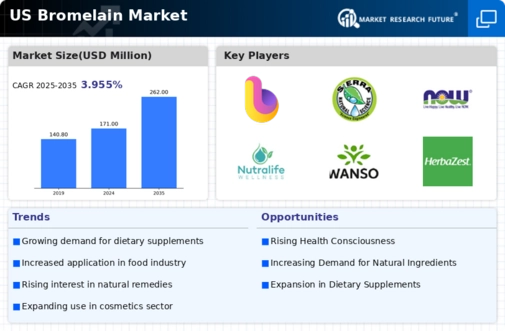The US Bromelain Market has become increasingly competitive in recent years, driven by the growing awareness of the health benefits associated with bromelain, a proteolytic enzyme extracted from pineapples. This market is characterized by a diverse array of players, ranging from established companies to emerging firms specializing in natural ingredients and dietary supplements. The competitive landscape is influenced by various factors, including technological advancements in enzyme extraction methods, the rising demand for plant-based products, and an uptick in the popularity of health-conscious consumer behavior.
Additionally, trends such as the increasing number of health supplements and functional foods incorporating bromelain, owing to its anti-inflammatory and digestive properties, further enhance competition. With the US market exhibiting significant potential, firms are continually striving to strengthen their product offerings and market reach to capture a larger share.VitaSage has established a strong presence in the US Bromelain Market by focusing on high-quality formulations that appeal to health-conscious consumers. The company is recognized for its commitment to sourcing the best raw materials and employing advanced extraction methods, ensuring the purity and efficacy of its bromelain products.
VitaSage emphasizes innovation in its product development, catering to various customer segments, including dietary supplements, food and beverage industries, and personal care products. One of the company's key strengths lies in its extensive distribution network, which allows it to reach a wide audience across the United States. Additionally, VitaSage's dedication to research and development positions it favorably in adapting to market trends and consumer demands, ensuring that its offerings remain competitive in the ever-evolving landscape of health supplements.Sierra Natural Science has carved out its niche in the US Bromelain Market by focusing on the pharmaceutical and nutraceutical sectors.
The company features a lineup of key products that highlight the benefits of bromelain, catering specifically to applications like inflammation reduction, digestive health, and post-operative recovery. Sierra Natural Science's strengths include its robust research capabilities, which enable it to stay ahead in innovation for product development. The company has also engaged in strategic mergers and acquisitions to enhance its presence in the market, ensuring that it can offer a comprehensive product range that meets varied consumer needs.
Furthermore, Sierra Natural Science invests significantly in marketing efforts to promote the health benefits of bromelain, thus reinforcing its competitive position throughout the US. The company aims to leverage its expertise in the natural product industry, further solidifying its reputation as a trusted provider of high-quality bromelain solutions in the market.




















